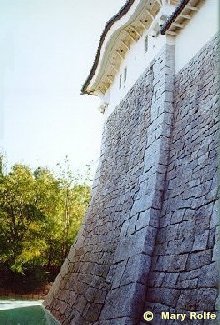JAPAN
World Showcase at EPCOT

Wall
World Showcase at EPCOT

Wall
Help came in the form of contributor Chad Pastor and this is what he adds:
Under Tokugawa rule, Japan entered a period of national seclusion (sakoku). Japanese were forbidden to travel to foreign lands or to return from foreign lands, or face death. Trade was restricted to very few places, like Dejima Island near Nagasaki and only with Dutch,
Chinese, and Koreans under strict supervision. They could only contact merchants and prostitutes.
This period came to an end in 1853, when Commodore Matthew Parry of the US Navy rolled into port with his squadron of "black ships" (steamers) to demand trade with Japan.
The Japanese blamed the Tokugawa government for not protecting Japan from the West and in 1867, Keiki resigned and the Emperor Meiji resumed state control--thus began the Meiji Restoration.
Found toward the back of the Japanese pavilion is this great wall. Our tour guide told us about Japan's feel for the need to keep out western invasion, but I didn't get the time period. She also talked of Admiral Perry's reopening Japan, so whatever it was, it was before Perry. Any help out there?.
The time period was the Tokugawa, or Edo Period (1600-1867). In part, this time period was a reaction to the Christian Century (1543-1640). (keep in mind that the Emperor did not really hold any power and the country was run by Warlords.) Yes, I know the dates overlap, but that's because the date 1600 signifies the defeat of Hideyoshi Tokugawa's defeat of
Toyotomi Hideyori at the hands of Tokugawa Ieyasu.
Back to A Pansoph's Walt Disney World
Future World |
Magic Kingdom |
MGM
Animal Kingdom
Pansophist.com |
Pet Portraits |
art gallery
Pansophilosophy |
Pansophism
Tower Case of Terror |
The Squash that took over the Lilac
Replica of Titanic's Le Coeur de la Mer |
My Jaguar
All images on this site are © by Mary Rolfe/Pansophist at http://www.pansophist.com/